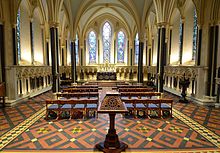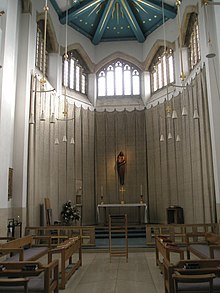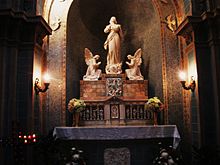| Part of a series on the |
| Mariology of the Catholic Church |
|---|
 Immaculate Conception by Bartolomé Esteban Murillo (c. 1675) Immaculate Conception by Bartolomé Esteban Murillo (c. 1675) |
| Overview |
| Titles of Mary |
| Prayers and hymns |
| Devotional practices |
Movements and societies
|
| Apparitions |
Key Marian feast days
|
|
|
A Lady chapel or lady chapel is a traditional British term for a chapel dedicated to Mary, mother of Jesus, particularly those inside a cathedral or other large church. The chapels are also known as a Mary chapel or a Marian chapel, and they were traditionally the largest side chapel of a cathedral, placed eastward from the high altar and forming a projection from the main building, as in Winchester Cathedral. Most Roman Catholic and many Anglican cathedrals still have such chapels, while mid-sized churches have smaller side-altars dedicated to the Virgin.
The occurrence of lady chapels varies by location and exist in most of the French cathedrals and churches where they form part of the chevet. In Belgium they were not introduced before the 14th century; in some cases they are of the same size as the other chapels of the chevet, but in others (probably rebuilt at a later period) they became much more important features. Some of the best examples can be found in churches of the Renaissance period in Italy and Spain.

It was in lady chapels, towards the close of the Middle Ages, that innovations in church music were allowed, only the strict chant being heard in the choir.
In late Old English the word 'lady' belonged to a declension of feminine nouns which were uninflected for the singular possessive, and the name (Our) Lady Chapel is a fossilized vestige. It should be understood as (Our) Lady's Chapel
In England
In the 12th-century legends surrounding King Lucius of Britain, the apostles Fagan and Duvian were said to have erected the Lady Chapel at Glastonbury as the oldest church in Britain; the accounts are now held to have been pious forgeries. The earliest English lady chapel of certain historicity was that in the Saxon cathedral of Canterbury; this was transferred during the rebuilding by Archbishop Lanfranc to the west end of the nave, and again shifted in 1450 to the chapel on the east side of the north transept. The lady chapel of Ely Cathedral is a distinct building attached to the north transept, which was built before 1016. At Rochester the current lady chapel is west of the south transept (which was the original lady chapel, and to which the current chapel was an extension).
Probably the largest lady chapel was built by Henry III in 1220 in Westminster Abbey. This chapel was 30 feet (9.1 m) wide, much in excess of any foreign example, and extended to the end of the site now occupied by Henry VII's Lady Chapel. Also in 1220, the office of Warden of the Lady Chapel was established, with the responsibility for the Lady altar, and its sacred vessels, candles and other accoutrements.
Among other notable English examples of lady chapels are those at the parish church at Ottery St Mary, Thetford Priory, Bury St Edmunds Cathedral, Wimborne Minster and Highfield Church in Hampshire. The Lady Chapel was built over the chancel in Compton, Guildford, Surrey; Compton Martin, Somersetshire; and Darenth, Kent. At Croyland Abbey there were two lady chapels. The Priory Church at Little Dunmow was the lady chapel of an Augustinian priory, and is now the parish church. The Lady Chapel in Liverpool Cathedral is another, more recent, example. Consecrated in June 1910, it was designed by George Gilbert Scott and is noteworthy for its size and beauty.
Salisbury and Truro cathedrals have an eastern chapel that is equivalent to a lady chapel but with a different name, as a result of the whole church being dedicated to Mary.
Places
| This list is incomplete; you can help by adding missing items. (February 2015) |
Canada
- The Lady Chapel at the Cathedral Church of the Redeemer in Calgary, Alberta
Ireland

- The Lady Chapel of St Patrick's Cathedral in Dublin
- The Lady Chapel of Christ Church Cathedral in Dublin
New Zealand
- The Lady Chapel at St Paul's Cathedral in Wellington
Russia
- The Lady Chapel at Catholic Church of St. Catherine in Saint Petersburg
South Africa
- The Lady Chapel of St Cyprian's Cathedral in Kimberley
United Kingdom




- The Lady Chapel at Glastonbury Abbey, formerly supposed to be the oldest church in Britain
- The Lady Chapel at Canterbury Cathedral, the probable first Lady chapel in Britain
- The Elder Lady Chapel at Bristol Cathedral in England
- The Eastern Lady Chapel at Bristol Cathedral in England
- The Lady Chapel at Chester Cathedral in England
- The Lady Chapel at Chichester Cathedral in England
- The Lady Chapel at Ely Cathedral in England
- The Lady Chapel at Gloucester Cathedral in England
- The Lady Chapel at Hereford Cathedral in England
- The Lady Chapel at Liverpool Cathedral (Anglican) in England
- The Lady Chapel at Liverpool Metropolitan Cathedral (Catholic) in England
- The Lady Chapel at Manchester Cathedral in England
- The Lady Chapel at Rochester Cathedral in England
- The Lady Chapel at Wells Cathedral in England
- The Lady Chapel at Westminster Abbey (Anglican), also known as the "Henry VII Chapel"
- The Lady Chapel of Westminster Cathedral (RC) in England
- The Lady Chapel of Winchester Cathedral in England
- The Lady Chapel at St Alban's in Southampton, England
- The Lady Chapel at All Saints' in London, England
- The Lady Chapel at St Augustine's in Birmingham, England
- The Lady Chapel at Christ the King's in London, England
- The Lady Chapel at Holy Cross in Crediton, England
- The Lady Chapel at Holy Cross in Waltham Abbey, England
- The Lady Chapel at St Clare's in Liverpool, England
- The Lady Chapel at St David's in Pantasaph, Wales
- The Lady Chapel at St Jude's-on-the-Hill in London, England
- The Lady Chapel at St George's in Birmingham, England
- The Lady Chapel at St Helen's in Ashby-de-la-Zouch, England
- The Lady Chapel at St James the Great's in Haydock, England
- The Lady Chapel at St John the Baptist's in Chester, England
- The Lady Chapel at St Mary's in Stamford, England
- The Lady Chapel at St Mary's in Widnes, England
- The Lady Chapel at St Mary Magdalen's in Woolwich, England
- The Lady Chapel at St Mary Magdalen's in Yarm, England
- The Lady Chapel at St Mary the Virgin's in Stanton Drew, England
- The Lady Chapel at St Matthew's in Oxhey, England
- The Lady Chapel at St Matthew's in Westminster, England
- The Lady Chapel at St Michael's in St Michael Caerhays, Cornwall
- The Lady Chapel at St Michael's in Tilehurst, England
- The Lady Chapel of St Pancras's in Ipswich, England
- The Lady Chapel at St Peter's in Berkhamsted, England
- The Lady Chapel at St Peter's in Sudbury, England
- The Lady Chapel at Holy Trinity in Trowbridge, England
- The Lady Chapel at Windsor Castle, now formally the "Albert Memorial Chapel"
United States
- The Lady Chapel at Manhattanville College in Purchase, New York
- The Lady Chapel at St. Mark's Church, Rittenhouse Square in Philadelphia, Pennsylvania
- The Lady Chapel at Church of the Good Shepherd (Rosemont, Pennsylvania)
- The Lady Chapel at the Basilica of the Sacred Heart, Notre Dame), Indiana
- The Lady Chapel at the Church of the Advent, Boston, Massachusetts
- The Lady Chapel at St. Patrick's Cathedral, (Manhattan).
See also
- Roman Catholic Marian churches
- St. Mary's Church (disambiguation), for independent churches dedicated to the Virgin Mary
- The Lady Chapel, a 1994 novel by Candace Robb
References
- Cathedrals by Robin S. Oggins 2000 ISBN 0-281-05349-9 page 43
- Mary: The Imagination of Her Heart by Penelope Duckworth 2004 ISBN 1-56101-260-2 pages 125-126
- Alston, George Cyprian. "Chapel", The Catholic Encyclopedia. Vol. 3. New York: Robert Appleton Company, 1908. 3 Dec. 2013
- "Extended Grammar".
- William of Malmesbury. Gesta Regum Anglorum . c. 1140. Translated by J.A. Giles as William of Malmesbury's Chronicle of the Kings of England from the Earliest Period to the Reign of King Stephen, p. 21. Henry G. Bohn (London), 1847.
- Herbermann, Charles, ed. (1913). "Devotion to the Blessed Virgin Mary" . Catholic Encyclopedia. New York: Robert Appleton Company.
- Harvey, Barbara F. The Obedientiaries of Westminster Abbey and Their Financial Records, C. 1275-1540. Boydell Press. p. 95.
- White, Norval, and Elliot Willensky. AIA Guide to New York City. 5th ed. New York: Oxford UP, 2010. Print.
![]() This article incorporates text from a publication now in the public domain: Chisholm, Hugh, ed. (1911). "Lady-chapel". Encyclopædia Britannica. Vol. 16 (11th ed.). Cambridge University Press. p. 62.
This article incorporates text from a publication now in the public domain: Chisholm, Hugh, ed. (1911). "Lady-chapel". Encyclopædia Britannica. Vol. 16 (11th ed.). Cambridge University Press. p. 62.
![]() This article incorporates text from a publication now in the public domain: Herbermann, Charles, ed. (1913). "Chapel". Catholic Encyclopedia. New York: Robert Appleton Company.
This article incorporates text from a publication now in the public domain: Herbermann, Charles, ed. (1913). "Chapel". Catholic Encyclopedia. New York: Robert Appleton Company.